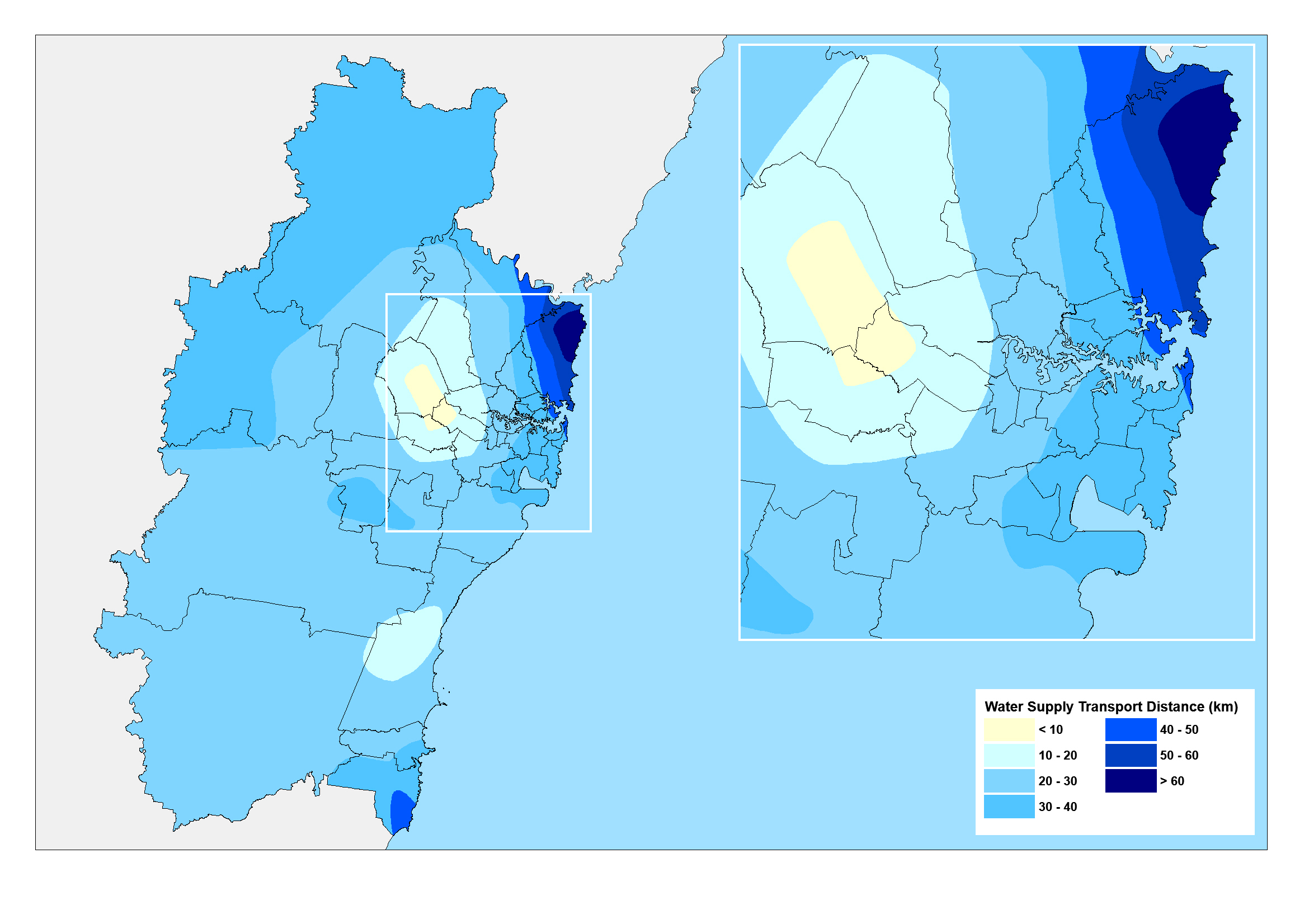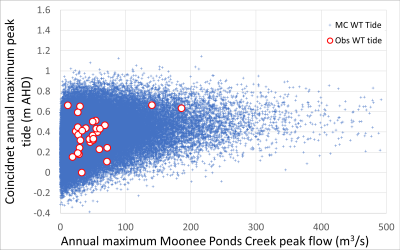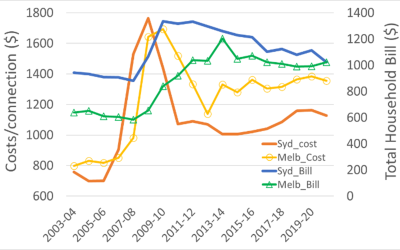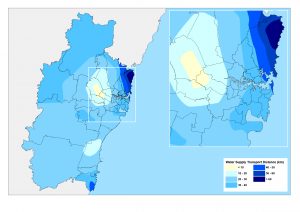
Water supply transfer distances for Greater Sydney
Alternative Water Plan for Sydney
Peter J Coombes, Michael Smit and Michael Barry
Sydney is the premier Australian city and it faces profound urban water challenges. Sydney must manage its infrastructure efficiently and sustainably to compete internationally as a Global city. Sydney has a strongly performing water services sector but has a traditional approach to water service management.
Significant challenges include long transfer distances for water and sewage services, inadequate sewage treatment, severe urban heat island problems in the rapidly growing west and inadequate urban stormwater infrastructure management.
These problems appear to be intractable using traditional water analysis approaches. However a Systems Framework investigation can identify efficient solutions and new opportunities.
The Systems Framework methodology was recognised in 2018 by Engineers Australia as leading water resource research.[1]
Options
The Systems Framework is used to model and compare the performance of four Options.
The Business as Usual (BAU) Option considers current water cycle (water, sewage, stormwater and environment) management practices and BASIX policies across the Greater Sydney region.
The second Option (NoBasix) examines the impacts of removing the BASIX policy in 2010 to document the benefits of the state planning policy.
A third Option is a new BASIX (NewBasix) that includes stormwater volume targets and improved online tools designed to address key Greater Sydney challenges.
The final Option (BSX_Price) applies a single usage tariff for water and sewage services, and a single impervious area tariff for stormwater management. This option abandons fixed tariffs to provide greater incentives to utilities and citizens for efficient water use and stormwater management.
Results
The key insight is that a combination of supply and demand management is more efficient than relying entirely on supply solutions when considering whole of society benefits. These demand management solutions include behaviour change, water efficient appliances and rainwater harvesting. An example of these benefits is a 5 year deferral of the multi-billion dollar desalination augmentation provided by the BASIX policy. The inclusion of rainwater harvesting as a stormwater management solution has both infrastructure and demand management benefits and is an efficient decentralised infrastructure asset that improves the performance of the whole system.
An Efficient Sydney
This report finds that Greater Sydney, despite significant challenges, currently has the most efficient and sustainable water services in Australia.[2] This has been achieved through the strategic alignment of water demand management, rainwater harvesting and urban development.
The BASIX state environmental planning policy has built-in demand management and stormwater management in most new buildings in the Greater Sydney region since 2004 and this ‘bottom up’ approach has a major legacy impact on the efficiency of water services. BASIX policies will save the Greater Sydney region about 139 billion litres of water annually by 2050.
Water and Sewage Transport Logistics
This investigation has identified water and sewage transfer distances of over 50 km across Greater Sydney. Transporting a heavy liquid over these distances and significant changes in ground elevations represents high capital and operational costs and potential economic inefficiencies.
In some parts of Greater Sydney, the shadow cost (medium run marginal cost) of delivering water and sewage services is greater than $16/kL, which is nearly 800% more than the household usage tariff, as shown in Figure 1.
Stormwater Management
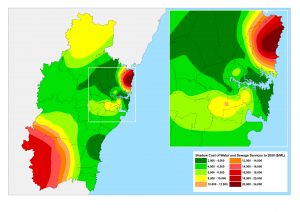
Figure 1: Spatial marginal costs of utility water and sewage services to Greater Sydney
Stormwater management is emerging as one of the most significant urban infrastructure challenges[3]. The stormwater infrastructure established often more than 50 years ago is inadequate for modern challenges.[4][5] However, it is prohibitively expensive to retrofit traditional infrastructure into existing urban areas.
Greater Sydney is experiencing a higher than expected level of urban infill development which increases impermeable surface areas and generates greater urban stormwater runoff.
Climate Change predictions from the IPCC are for more intense rainfall events from summer storms that significantly increases the flooding risk.[6]
The Value of Source Controls
Importantly the improved BASIX program to 2050 provides net present values of $4.3 billion (4% discount rate) through at source controls. These approaches improve stormwater service costs, nutrients loads discharging to waterways and flood risk compared to not having BASIX. If you include legacy benefits this value increases to $6.1 billion.
Summary
The options for future water cycle management examined in this study reveals that an improved BASIX policy with stormwater and green infrastructure will further reduce water and sewage utility costs by over $1 billion and provide net benefits of over $1.6 billion to 2050. The difference between no BASIX and improved BASIX policies from 2010 to 2050 is a net present benefit of $7 billion. Improved water and sewage tariffs to deliver accurate price signals will have even greater benefits.
This research was conducted in partnership with Kingspan Water & Energy and BMT. Download the research report here: Alternative Water Strategy for Sydney
References
[1] Barry M.E., and Coombes P.J., (2018), Planning resilient water resources and communities: the need for a bottom-up systems approach, Australasian Journal of Water Resources, 22(2), 113-136 – Awarded the GN Alexander Prize for Hydrology and Water Resources 2018
[2] Coombes, P.J., Barry, M., & Smit, M. (2018). Systems Analysis And Big Data Reveals Benefit Of New Economy Solutions At Multiple Scales. WSUD 2018 & Hydropolis conference, Engineers Australia, Perth.
[3] Australian Senate (2015), Stormwater Management in Australia. Environment and Communications References Committee of the Australian Senate, Commonwealth Government of Australia
[4] Coombes P. J., (2018), Status of transforming stormwater drainage to a systems approach to urban water cycle management – moving beyond green pilots, Australasian Journal of Water Resources, 22:1, 15-28.
[5] State of Victoria. (2018). Improving Stormwater Management Advisory Committee Final Report. East Melbourne: Department of Environment, Land, Water and Planning.
[6] Coombes P. J., Roso S., (2018), Editors, Book 9: Runoff in Urban Areas, Australian Rainfall and Runoff, Commonwealth of Australia (Geosciences Australia), Australia

